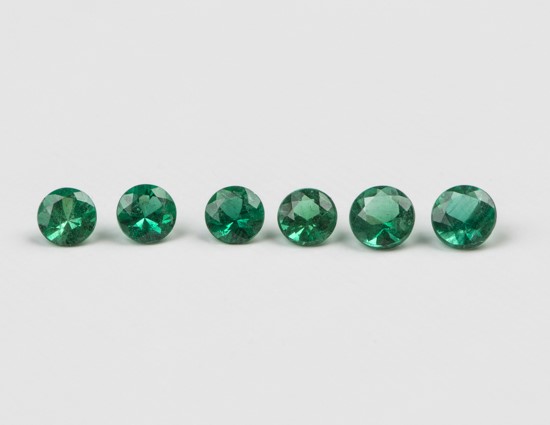Where can you find the emeralds you need?
Pierres de Charmes carries a vast selection of fine quality emeralds. Our collection of well-cut stones includes many different shapes and sizes including calibrated stones. Photo link
Emerald Fact Sheet
All beryls, including emerald, have a vitreous lustre and a hardness of 7.5 -8.0 on the Moh’s scale. However, emerald, because it is often included (emerald “garden”) is particularly fragile. This is why it is often fashioned as a square or rectangle with beveled corners.
|
Fact sheet
|
|
Chemical composition
|
Be3Al2(SiO3)6
|
|
Crystalline system
|
Hexagonal
|
|
Cleavage
|
Imperfect basal
|
|
Refractive index
|
1.577 – 1.583
|
|
Birefringence
|
0.003– 0.010
|
|
Specific gravity
|
2.65 –2.80
|
|
Anisotrope
|
Emerald is anisotropic and displays moderate dichroism of bluish green and yellowish green.
|
Gemmologists can use many different instruments to identify emerald. The trace amounts of chromium in its structure produce a diagnostic absorption spectrum, which can be seen with a small instrument called a spectroscope. Chromium also makes emerald appear red when viewed through a Chelsea filter.
The presence of specific inclusions such as various mineral crystals and multi-phase inclusions allow gemmologists to distinguish between natural and synthetic emeralds.
Rough emerald crystals are usually long, hexagonal prisms. The areas with fewer inclusions will be facetted while the more heavily included areas can be cut as cabochons.
Producing Countries
Emerald deposits are found primarily in Colombia, Brazil, Zambia, and Zimbabwe. There are also deposits in Siberia, India, Pakistan, and Egypt. Certain inclusions found in emeralds are associated with specific deposits providing gemmologists with a way to determine the geographic origin of some stones.
Emerald crystals form in metamorphic and hydrothermal environments. Some emerald crystals, found mainly in Colombia, contain dark coloured mineral intergrowth in the shape of a six-armed star. These are called Trapiche emeralds and when cut as cabochons or slices the dark star shape produces a beautiful effect.
Is emerald treated?
Most emeralds contain fissures and they are often treated with a process called fracture filling. The gem is immersed in oil and gently heated in a vacuum chamber. This allows the oil to penetrate the surface reaching fractures making them less visible and thereby improving the stone’s transparency and appearance. The trade considers this an acceptable treatment and the majority of emeralds have been treated in this way. The treatment is not permanent however it can be repeated if needed. Emeralds may also be dyed to improve their colour and this treatment should always be disclosed.
Emerald in jewellery
Emeralds are a staple on the world’s red carpets and since antiquity have been a favorite of celebrities and royals alike. Emerald is also the birthstone for the month of May and the gemstone for the thirty-fifth wedding anniversary.
Value and quality criteria
Colour is the most important criteria for emerald. Fine quality stones show an intense saturated and homogeneous green with a high degree of transparency. These stones must be well cut to optimize their brilliance. A naturally transparent untreated emerald will have a higher value than a treated stone of similar appearance. Geographic origin may also play a role in value amongst collectors and connoisseurs.
Fun Fact
The first known emerald deposits were located in Egypt. It is believed that they were mined around 3500 BC. Cleopatra is said to have adored emeralds and they were featured prominently in her jewellery. According to some legends, emeralds are thought to protect sailors from danger at sea.
*In gemmology, as in nature, a species refers to a group with related members who share common features. In gemmology, the varieties or members of a species, share a common chemical composition of atoms organized in identical repeating patterns. In most cases the individual varieties are differentiated by the presence of small amounts of a chemical element that causes the particular colours associated with the different varieties.
Gem property Chart A [Chart]. (n.d.). In Gemological Institute of America (GIA).1992
(2010). Bér-1. In Cours de base en gemmologie Gem-A. London.
(2010). Bér-2. In Cours de base en gemmologie Gem-A. London.
Emerald Gemstone | Emerald Stone – GIA. (n.d.). Retrieved July 19, 2016, from http://www.gia.edu/emerald
Emerald Gemstone | Emerald Stone – GIA. (n.d.). Retrieved July 19, 2016, from http://www.gia.edu/emerald#buyers-guide
Emerald History and Lore. (n.d.). Retrieved July 19, 2016, from http://www.gia.edu/emerald-history-lore

















